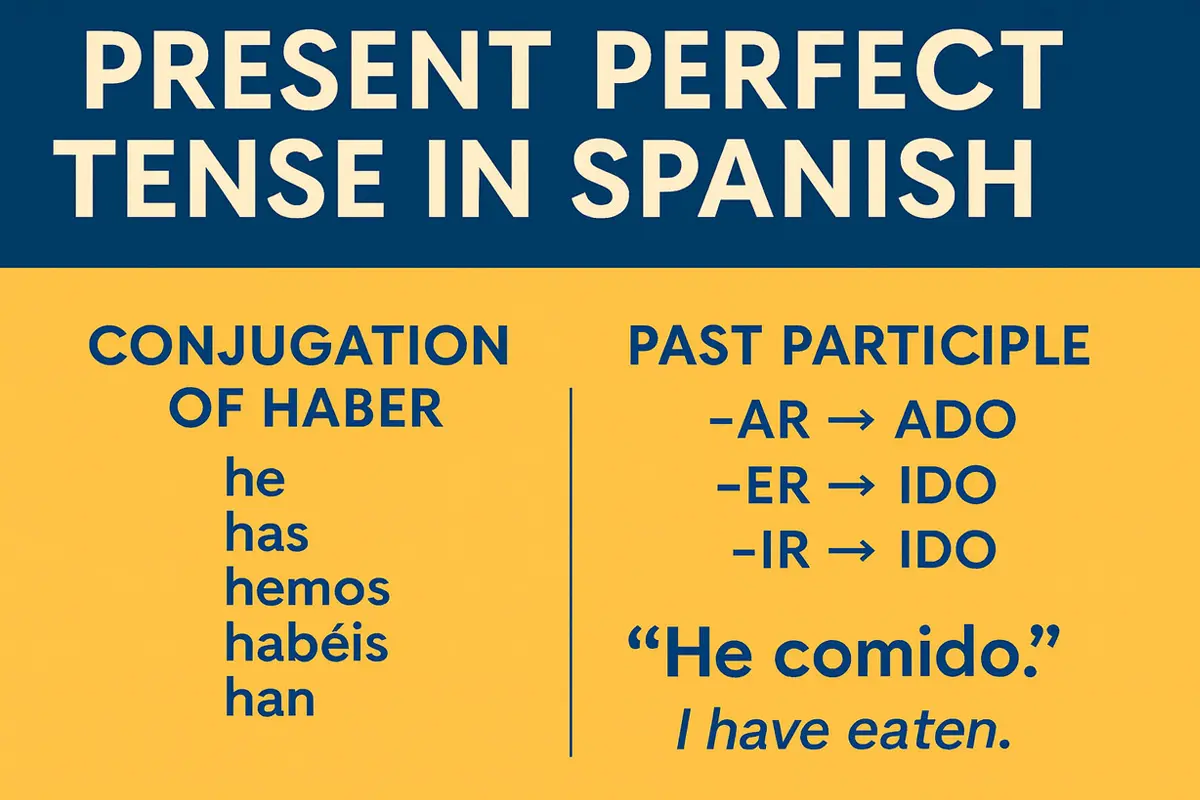
If you’re wondering what the present perfect tense in Spanish is, here’s the quick answer: it’s a compound tense used to talk about actions that have happened over a period of time, have relevance to the present, or were completed recently. You form it with the auxiliary verb haber in the simple present plus a past participle. For example: He comido means “I have eaten.”
This tense is essential if you want to talk about actions without focusing on a specific time in the past. In this guide, you’ll learn how to form the present perfect, use it with object pronouns, avoid common mistakes, and sound natural whether you’re in Spain or Latin America.
What Is the Present Perfect Tense in Spanish?
The present perfect, known as el pretérito perfecto compuesto, connects the past with the present. It’s used for:
- Actions completed recently: He visto esa película — “I have seen that movie.”
- Experiences at any unspecified time: Hemos viajado a México — “We have traveled to Mexico.”
- Actions that still matter now: Han terminado el trabajo — “They have finished the work.”
It differs from the simple past because it focuses on present relevance, not just when something happened.
How to Form the Present Perfect Tense in Spanish
Formula:
Present tense of haber + past participle of the main verb
Conjugation of haber in the simple present:
| Person | Conjugation |
|---|---|
| Yo | he |
| Tú | has |
| Él/Ella/Usted | ha |
| Nosotros/as | hemos |
| Vosotros/as | habéis |
| Ellos/Ellas/Ustedes | han |
Examples:
- Yo he estudiado — “I have studied.”
- Ellos han comido — “They have eaten.”
- Ya hemos terminado — “We have already finished.”
Forming Past Participles
For regular verbs:
- -ar verbs → stem + -ado (hablar → hablado)
- -er verbs → stem + -ido (comer → comido)
- -ir verbs → stem + -ido (vivir → vivido)
Common irregular past participles:
- abrir → abierto (“opened”)
- decir → dicho (“said”)
- escribir → escrito (“written”)
- hacer → hecho (“done”)
- ver → visto (“seen”)
When to Use the Present Perfect Tense
1. Recent Past Actions
When something happened shortly before now:
- He terminado el informe. — “I have finished the report.”
2. Life Experiences
Talking about things you’ve done over a period of time:
- ¿Has probado sushi? — “Have you tried sushi?”
3. Actions with Ongoing Relevance
When the result still matters:
- Hemos perdido las llaves. — “We have lost the keys.”
4. With Specific Time Expressions (Spain)
In Spain, it’s common to use the present perfect with esta semana, hoy, or este mes:
- Hoy he ido al médico. — “I have gone to the doctor today.”
Common Time Expressions
- hoy — today
- esta semana — this week
- este mes — this month
- últimamente — lately
- ya — already
- todavía no — not yet
- tres veces — three times
Present Perfect with Object Pronouns
Object pronouns (direct or indirect) are placed before haber:
- Lo he visto. — “I have seen it.”
- Te he enviado un mensaje. — “I have sent you a message.”
- Les hemos explicado el problema. — “We have explained the problem to them.”
Common Mistakes to Avoid
-
Mixing up with the simple past
- In Latin America, many prefer the simple past for recent events:
Ayer vi la película vs. He visto la película.
- In Latin America, many prefer the simple past for recent events:
-
Using the wrong placement of pronouns
- Remember: pronouns go before haber, not before the participle.
-
Forgetting that the past participle doesn’t agree
- Unlike adjectives, participles don’t change for gender/number here.
Present Perfect vs. Simple Past
| Present Perfect (He hablado) | Simple Past (Hablé) |
|---|---|
| Highlights present relevance | Focuses on when it happened |
| Often used with “esta semana,” “hoy” | Used with a specific time (ayer, el año pasado) |
| Flexible for experiences | Concrete and completed in the past |
Tips for Sounding Natural
- Use markers like ya and todavía no for nuance.
- Practice with experiences: He viajado a España tres veces.
- In informal conversation, shorten and blend words naturally.
Practice Exercises
-
Fill in with the correct form of haber and the participle:
- Yo ___ (visitar) Madrid.
- Ellos ___ (comer) en ese restaurante.
- Tú ___ (escribir) una carta.
-
Translate:
- I have read that book.
- We have visited Paris.
- Have you finished the homework?
Final Thoughts
Mastering the present perfect tense in Spanish helps you connect past actions to the present naturally. By knowing when to use it, how to combine it with object pronouns, and practicing daily, you’ll communicate more like a native speaker—whether you’re in Latin America or Spain.